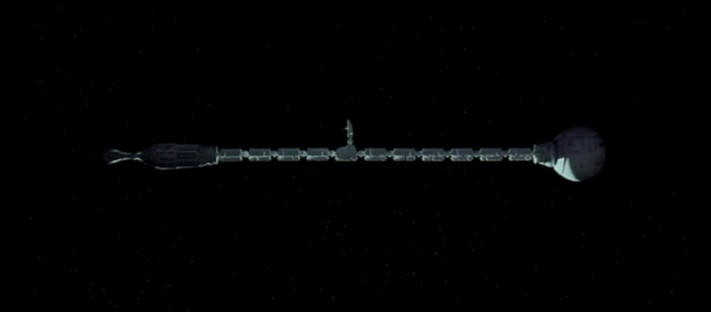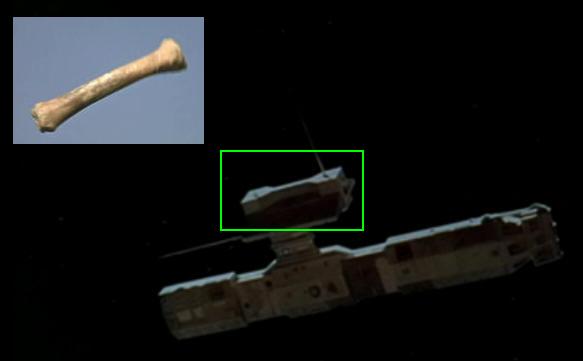
“Kubrick: and beyond the cinema frame”
An in-depth analysis of
2001: A SPACE ODYSSEY
Text copyright © by Rob Ager 2008
(last updates added 2015)
CHAPTER 8
THE TECHNOLOGY TRAP
Now we come to an aspect of 2001 that has been written of extensively in relation to the HAL 9000 computer, but has largely been ignored regarding other aspects of the movie – the concept of humans being trapped or enslaved by their own technology.
The sequence of satellites orbiting the Earth gives itself away as a representation of space warfare. The very first one, which we cut to from the flying bone shot, has a bone shaped feature at the top, signifying it as a weapon just like the bone.

The other satellites include a German flag alongside what appears to be a black Maltese cross ...
... a Chinese air force insignia on the satellite in which the shot scrolls up to show the Moon ...
... and another air force type insignia appears on the satellite that is travelling toward a rising sun (possibly French or Bulgarian).
The musical composition of this scene is called The Blue Danube, which was also the name of Britain’s first nuclear weapon. So right away we have technology depicted as a threat to human existence.
It was apparently intended in an early version of the script that the starchild would simultaneously detonate all of these nuclear devices upon returning to Earth thus bringing an end to the space warfare threat [1]. Though this does not happen in the movie its significant that when the starchild returns to Earth there are no satellites or spacecraft to be seen. In fact we can’t even tell what point in human history Bowman has returned to.
Let’s now assess the complex interactions that lead to open warfare between HAL and the astronauts. Our first glimpse of the Discovery spaceship features a sombre piece of music that is totally at odds with the uplifting music featured in the space scenes before this part of the story. Frank Poole runs in circles like a mouse trapped in a technological wheel, trying to box his way out of a life that is completely dependent on technology. His punching gestures are as useless as the masculine posing of the apes who don’t realize they’re about to be clubbed over the head.
Many have interpreted HAL’s behaviour in the story as malfunctional, but there are a number of clues that his so-called “error” in predicting a fault with the AE-35 unit was actually a calculated lie. The first clue has been noted by many chess enthusiasts. The game that Poole has with HAL is a re-enactment of a game from Chernev’s “1000 best short chess games” book. The original match was played in 1910 between Roesch and Schlage in Hamburg. In this re-enactment HAL falsely announces a move of Queen to Bishop 3, which he should have read as Queen to bishop 6. HAL then lies about the impending checkmate and Poole resigns from the game without noticing that he has been deceived.
An important detail of the chess game shot is that Frank is seen mouthing his thoughts about what move to make. So HAL wins not just by lying about the game but also by lip reading in the same way that he does when anticipating Frank and Dave’s intention to seize back control of the ship.
The next significant lie that HAL tells is when talking to Dave Bowman. For starters HAL lures him into a false conversation by asking to see his drawings – as if a computer could genuinely appreciate human artwork. HAL then says he has been troubled by the rumours of something being dug up on the moon and asks for Dave’s opinion on the matter. This is also a false line of conversation because when HAL is later being shut down by Bowman a video recording reveals that HAL knew all along what the truth of the rumours was.
Bowman’s reply to the false question hits the nail on the head. He tells HAL “You’re working up your crew psychology report”. HAL replies “Of course I am. I know it’s a bit silly.” and then comes the crucial turning point. HAL twice repeats the line “Just a moment” and then announces the expected failure of the AE-35 unit. His dialogue repetition is of great importance. Considering the speed and power of HAL’s thought process, for him to become stuck in a loop for just a few seconds suggests that he has just gone through a mammoth series of calculations. So why would Bowman’s comment about the crew psychology report trigger HAL in this way? Quite simply, HAL’s mission orders include an emphasis on controlling the psychology of the crew members. By successfully lying to Poole in the chess game HAL was reaffirming that it had psychological control over him. When Bowman called HAL’s bluff about the mission rumours he accidentally changed the parameters of the mission. HAL suddenly realised that Bowman’s thought process could not be easily predicted or manipulated. And so HAL responded by testing Bowman again by lying about the faulty AE-35 unit. If Bowman had replaced the unit without question and without checking the data then HAL would have been satisfied with his gullibility and would not have turned hostile. However, Bowman calls HALs bluff a second time. Unlike Poole, who neglected to double check HAL’s comments about the chess game, Bowman decides to consult with his colleague and to report the AE-35 fault to mission control. After the faulty unit is replaced he double checks HAL’s claims again by manually giving the recovered unit a complete functionality test. HALs bluff is blown wide open for all to see – the unit is in perfect working order.
The debate between HAL, the astronauts and mission control over the unfounded fault predication further reveals the strategic differences between Poole and Bowman. When mission control claim that HAL is in error Poole gives away his hostility by crossing his arms, where as Bowman plays it cool and quickly devises a plausible excuse to arrange a private chat with his colleague in the pod.
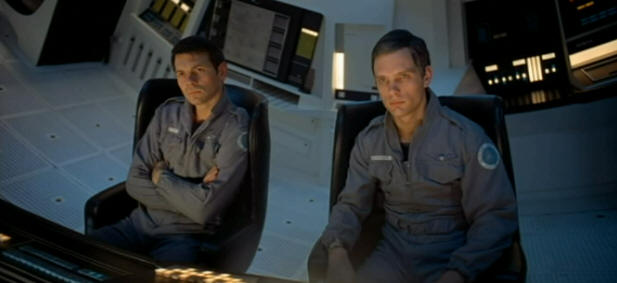
After lip reading their backup plans of shutting him down, HALs next response is to lure the crew members into a trap by asking them to put the “faulty” AE-35 unit back in place so that its apparent impending failure can be analyzed afterward. Obviously this was an excuse to lure one of the astronauts out and kill him. A very subtle hint of HALs premeditated murderous intent is that we see two meteorites spinning through space with the Discovery ship in the backdrop. This foreshadows the shot of Poole and the murderous space pod spinning off into the void.
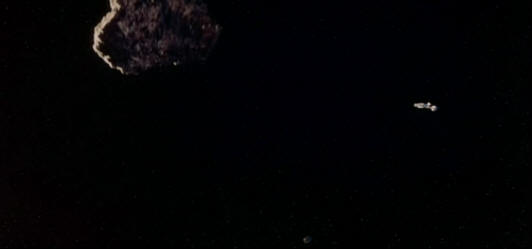
It’s possible that HAL was hoping Bowman would conduct the second replacement, which would have made it easy to eliminate the most threatening crew member first. However, Poole carries out the second replacement and is killed.
Now comes an interesting question. What backup plan did HAL have to get rid of Bowman after killing Poole? Perhaps it wasn’t expecting him to fly out in one of the other pods and recover Franks body. By recovering the body Bowman would soon discover the severed pipes in Frank’s breathing apparatus, revealing that he was murdered by HAL. If he hadn’t tried to recover the body then HAL could have offered any concoction of lies needed to keep Bowman quiet and then murdered him in his sleep along with the rest of the crew.
For the most part audiences have assumed that HAL had genuinely made a mistake in predicting the AE-35 fault and that the conflict afterwards was due to HALs desire not to be shut down. However, there is plenty of evidence to support a much more sinister hypothesis … that HAL was actually ordered by mission control to kill the crew.
For starters there are a multitude of references to IBM. The three letters comprising HALs name come just before the letters I, B and M in the alphabet. This was claimed by Arthur C Clarke to be a coincidence, but the other references you’re about to see demonstrate that Kubrick simply did not want to publicly acknowledge the encoded references.
Here are the additional IBM references that I’ve found so far.
The letters IBM are seen just above the computer display in the cockpit of the Pan am ship while it is docking in the torus station.
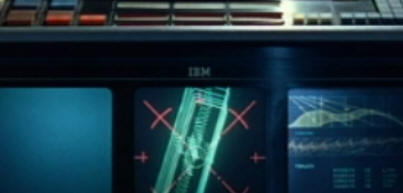
They are also seen written on the buttons of Bowman’s forearm console on his spacesuit - as he presses one of the buttons his finger is pointing directly at the black button featuring the letters IBM.
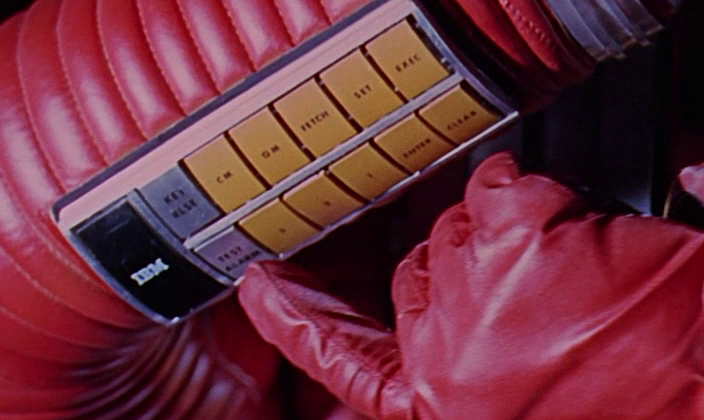
Frank Poole’s comment about HAL “I can’t quite put my finger on it” was possibly a hint of the finger pointing to the IBM button.
HAL also sings the song Daisy Bell as he is being shut down and announces that he was originally instructed by a Mr Langley at a computer plant in Urbana Illinois. In actual computing history the first demonstration of synthesized computer speech was produced in 1962 by an IBM704 computer at the Langley research facility in Urbana Illinois, in which it sung Daisy Bell. I mentioned earlier that ex-nazi Werner Von Braun developed the Torus anti-gravity space station concept for the US. Well this research was also fleshed out at Langley.
These computing corporation references are undeniable. Of course, 2001 was one of the first movies to feature product placement such as Pan Am and IBM logos, but I seriously doubt IBM would have been happy with being compared to the murderous HAL 9000. It’s just not good publicity.
For the most “in your face” evidence that HAL represents IBM, pay close attention as Bowman tries to talk HAL into letting him back on the Discovery. The computer console is displaying the letters across Dave’s face, which appear to read either IBM or MGM (the film's original distributors). Computer and tv screens do not display light in this way. They are designed to disperse light in all directions so as to be viewable from any angle. The fact that the letters are also displayed the right way around instead of backwards proves that the IBM / MGM reference is deliberate. And for tongue in cheek amusement Dave repeatedly asks “Do you read me HAL?”
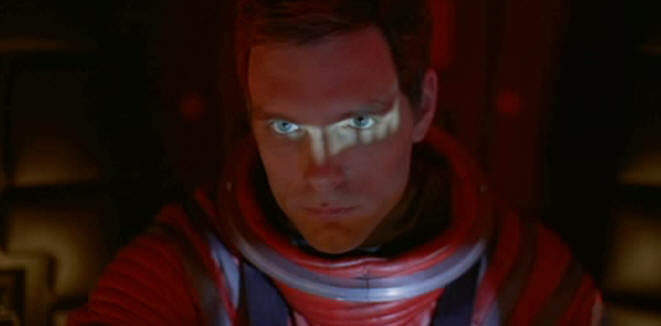
Later, when Bowman is switching off HALs higher brain functions, the white cells shine upon his face in an identical fashion.
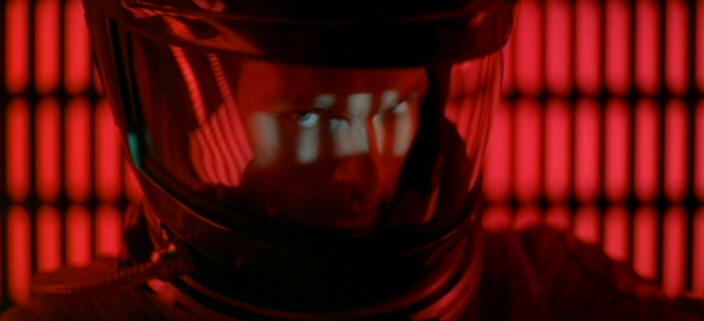
So we have very strong evidence that the HAL 9000 computer is at least partially representing IBM and it would seem that Kubrick had a certain disapproval of this giant corporation. Stanley’s motive may have been related to accusations regarding IBM’s early history. During World War 2 IBM apparently designed and sold basic computing machines to the Nazi regime that were used to process information about prisoners in concentration camps. These machines supposedly calculated who would be used for what kinds of cheap labour and who would be executed. In 2001 HALs systematic extermination of the sleeping crew may have been Kubrick’s statement about this historical tragedy, which IBM was never held accountable for.
The IBM references are Kubrick’s warning that computing corporations could eventually gain control over every aspect of our lives and turn us into disposable cogs in a giant technological wheel. For a powerful metaphor of this compare the shots of the yellow spinning bone thrown by the ape and the shots of Frank Poole spinning through space in his yellow suit. Like the bone, Frank has been used and tossed into the void - a disposable resource.
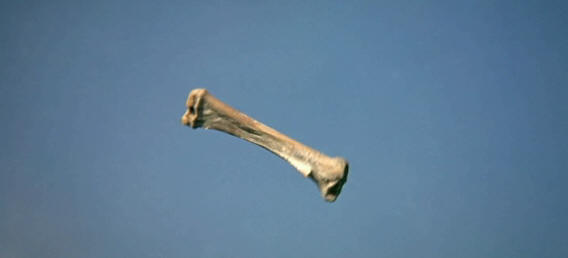
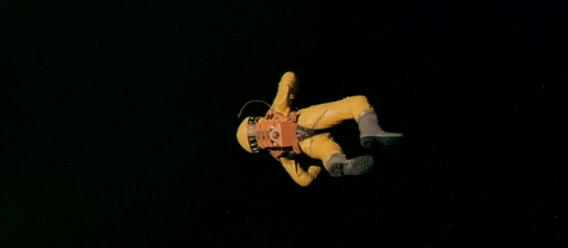
The name Frank Poole may also be a link to the Pool of water that is fought over by the apes, again symbolizing him as a resource.
The human beings of 2001 are utterly dependent on technology. Even the most basic living functions such as breathing, movement, eating, sleeping or simply going to the toilet have become unnatural and downright awkward. In stark contrast to the apes huddled together in the cave, family relationships are now conducted via satellite links. Frank Poole’s emotionless viewing of his parent’s birthday message demonstrates how this technology emotionally disconnects people. Notice also that Floyd’s daughter asks for a telephone for her birthday even though the family have lots of telephones already. She is expressing her desire for more satisfying communication. Even the woman who Floyd chats to in the Torus station explains that she and her husband hardly see each other and that he is doing some underwater research in the Baltic. This is an interesting piece of dialogue in that the slow movement of a deep sea diver wouldn’t look much different to that of an astronaut in zero gravity. Is Kubrick implying that people on Earth are as dependent on technology as those in space?
The astronauts are also hampered by HALs constant technological surveillance. When they have a private discussion in the space pod where HAL can’t hear them they suddenly adopt a more natural composure. Before this they were acting like robots.
The view from HALs eye is panoramic and as such there are many shots aboard the Discovery that use wide angle lenses – a reminder of HALs ever watchful eye. A distinctly eyeball shaped prop can be seen above the door of the podbay room and on the other side of the window is one of HALs many eyes with a view of the podbay room.
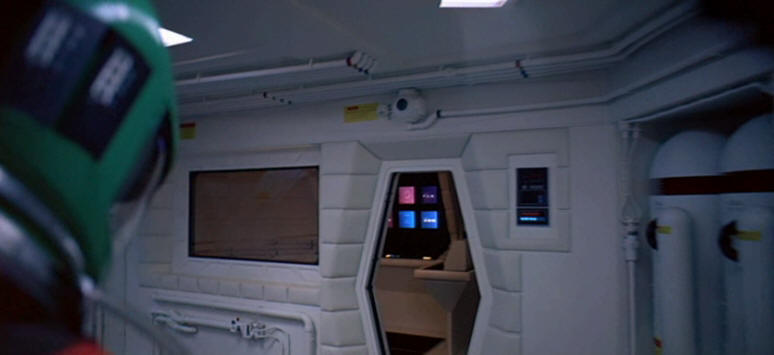
The three primary coloured space suits in the pod bay are an odd contrast to the silver space suits worn by Floyd and his colleagues and the helmets are resting several inches above the torsos. I’m not sure what this is symbolizing, but a possible clue is that when Bowman and Poole step into the centre pod we see two of the space helmets on either side of the screen, superimposed over the first and third of the three pods.
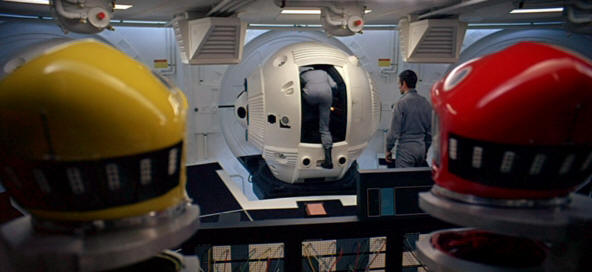
Is this suggesting that by evading HALs surveillance the astronauts are recovering their own head space? The division of the three suits into primary colours may also represent further fragmentation of the human mind. The helmets also have circular blue and white logos on them that are strangely positioned to look like eyes. And the importance of colour in the suits is emphasized after Bowman overcomes the vacuum of space in the airlock. He is wearing a green helmet when he shuts HAL down.
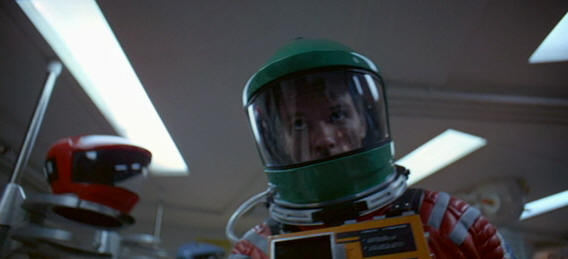
It is debatable whether a human could withstand the vacuum of space, as Bowman does, even for a few seconds. So taking into account the themes of technological inhibition, Bowman overcoming the vacuum of space could be symbolizing a recovery of forgotten physical abilities. After he overcomes the vacuum we find a drastic change in cinematography. The stiff and rigid camera movements comprising almost the entire film are replaced by loose handheld shots, hinting that Bowman has freed himself from HALs psychological prison. HAL desperately spouts lies and false sincerity to save himself, but Dave is now impervious to such deceptive tactics and he wastes no time in disconnecting HALs higher brain.
Now returning to the concept of HAL as a computing corporation, there are clues that the super-computer also represents the social hierarchy of the human race. Kubrick makes use of colour to communicate this message. HALs interior is an organic red and features clustered rows of cells, with each cluster obviously handling different functional responsibilities. The bright white cluster handles complex decision making and communication. This visual arrangement repeats elsewhere in the film.
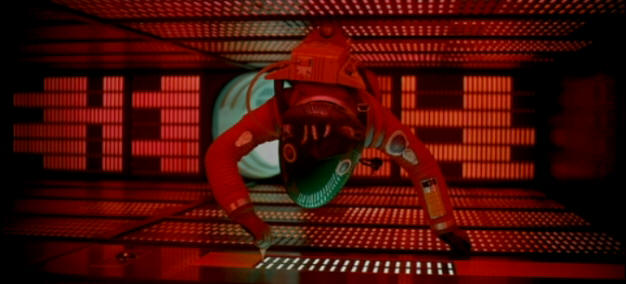
For example, the cockpit of the lunar landing craft is also bathed in red light and has white cell clusters above the windows.

More important though is the shot of the lunar hangar. The spherical landing craft is lowered underground into a large docking area that is bathed in red. If you look centre screen you’ll notice rows of white cells embedded in the walls, which are like HALs higher brain cells, and to emphasize their significance the shot ends right when the landing craft aligns with these cells.
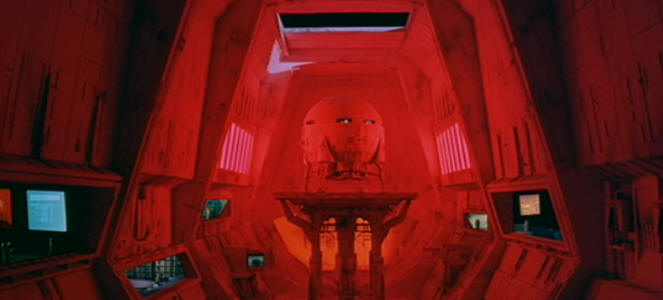
The other important aspect of this shot is that assorted rooms are embedded in the walls and in them are people carrying out their various functions as part of an organised hierarchy. The shot from inside the Torus station docking bay presents a similar depiction of social order and, though this shot isn’t bathed in red, we see in an external shot of the Torus that the opposite end of the docking bay is indeed bathed in red.
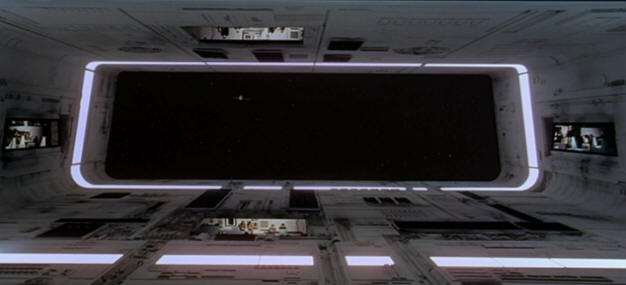
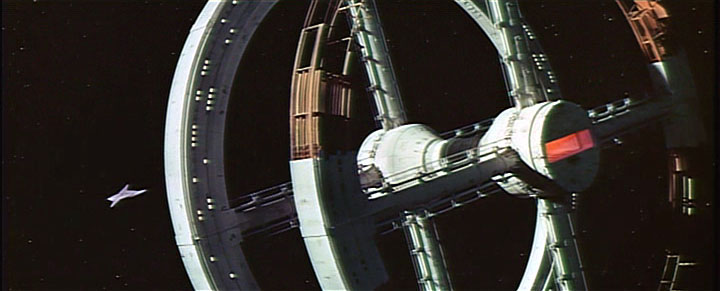
The idea of HALs brain cells being much larger may have been an aesthetic choice in the low angle hand held shot of Bowman opening the hatch to access HALs brain. The ceiling is made of long white lights and Bowman unscrews bolts to gain access.
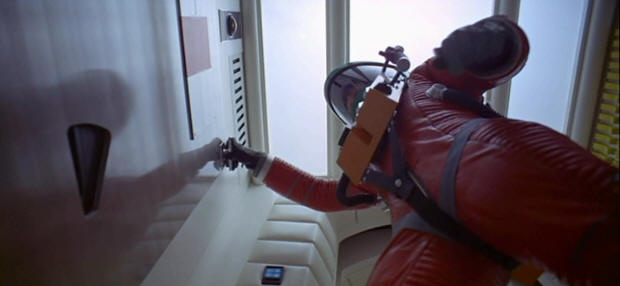
So the idea of HALs innards representing a large corporate social order or even the social order of the human race is not far fetched. If HAL had received orders to eliminate the crew then perhaps the scene of HALs disconnection is a metaphor for Dave Bowman rooting out and exposing a corrupt leadership. This concept of exposing corruption for all to see might explain why the white cells remain lit and pop out of the wall rather than simply switching off. To emphasize these ideas an important production still shows Kubrick standing over and smiling at the exposed white cells.
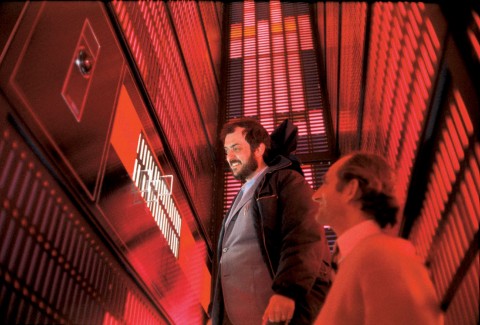
The two astronaut’s discussion in the pod about how to defeat HAL could even be Kubrick instructing his audience in how to defeat corrupt corporations who have fostered technological dependency, “Well we’d have to cut his higher brain functions without disturbing the purely automatic and regulatory systems”.
I seriously doubt that it was technology itself that Kubrick disapproved of because the man was a technical pioneer himself. My guess is he was warning us that corrupt organisations could use technology to render entire populations utterly dependent on them for their every physical needed, while keeping them psychologically in the dark and hence controlled. Isn’t this exactly the strangle hold that HAL has over the crew?
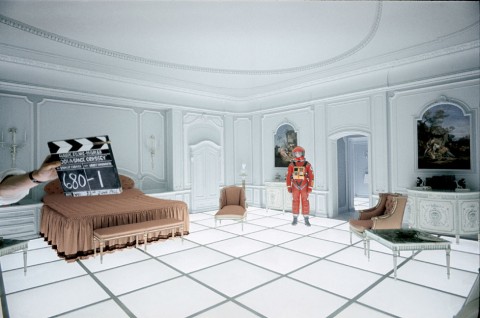
I’m now going to offer a new interpretation of 2001’s ending based upon this theme of man overcoming technological enslavement. We already know the monolith is a cinema screen and I’ve offered further interpretations that Bowman’s stargate journey takes him to the dimension outside his celluloid universe.
My next hypothesis is that the entire “Jupiter and beyond the infinite” section of the film is basically a dream sequence and that Bowman is actually asleep aboard the Discovery ship, which HAL is no longer in control of.
The ethereal shots of Jupiter and its moons have a hazy glow and lack of detail that is very dream-like and which sets them apart from the other space scenes.
The high speed light patterns of the stargate, while partially symbolizing a drain of colours and pigment to reveal an empty cinema screen, also represent Bowman’s newfound ability to process streams of complex information that he previously thought only advanced computers could do. A good indicator to this effect is that the stargate light patterns are not reflected on Bowman’s space helmet, but the computer panels of the pod are reflected.
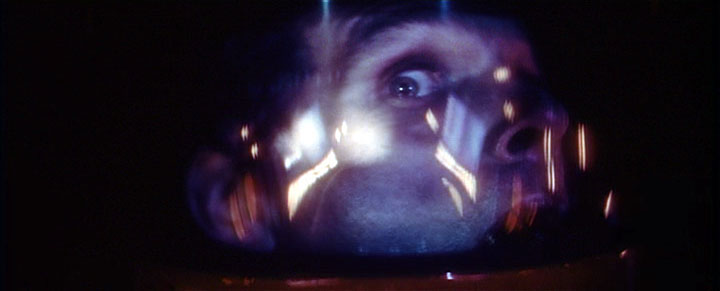
Colour also plays a role in the stargate. At one point the light patterns mimic the clusters of red lines that make up the walls inside HAL's interior.

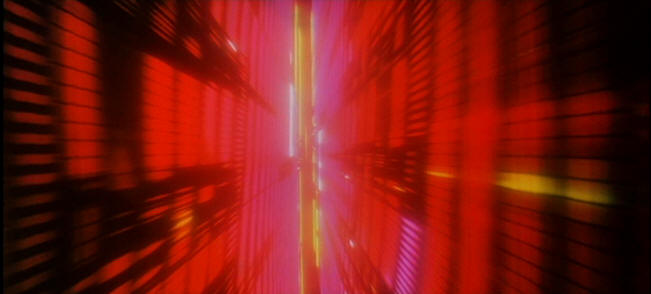
The pattern is then overwhelmed by bright white lines mimicking the brain cells that Dave unscrewed.
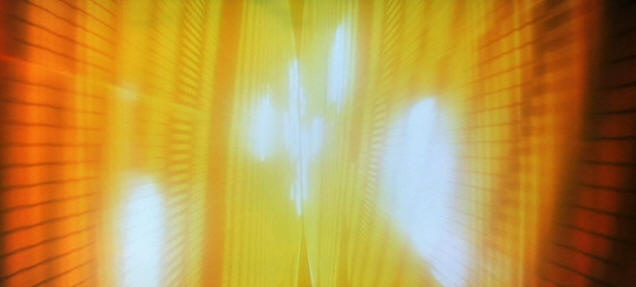
After a brief cut to Bowman's terror stricken face. We cut back to the stargate and an almost totally green section. Remember that Bowman put a green helmet on his red suit after surviving the airlock.
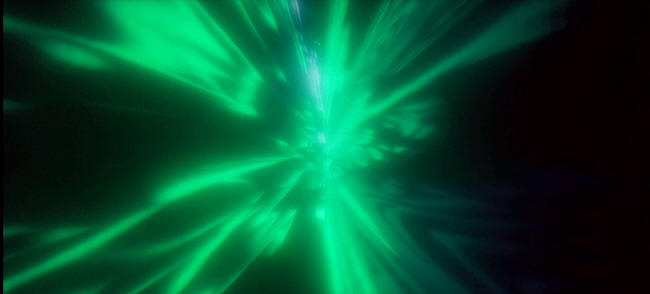
It's also possible that the green headboard pattern, upon which Bowman's aged body dies, was foreshadowed in the stargate.
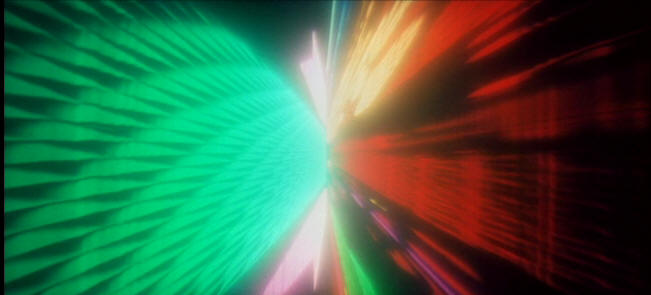
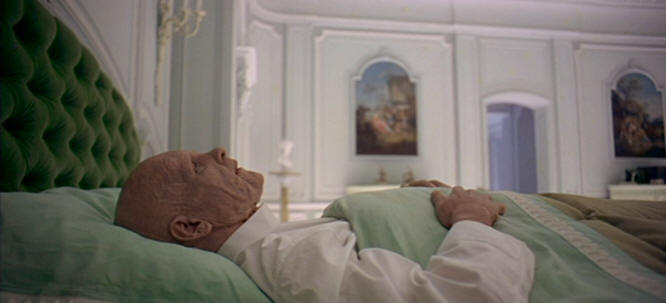
The wire frame computer displays on the Discovery also seem to reappear in organic forms during the rebirth sequence. Again this implies that Bowman's brain is outperforming the supposedly superior HALs thought process.
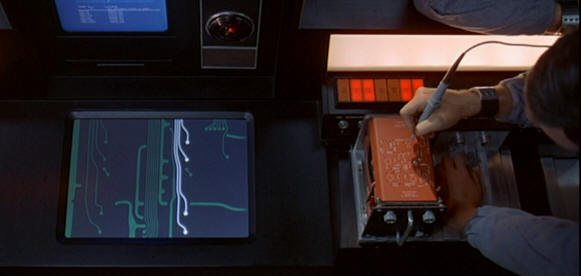
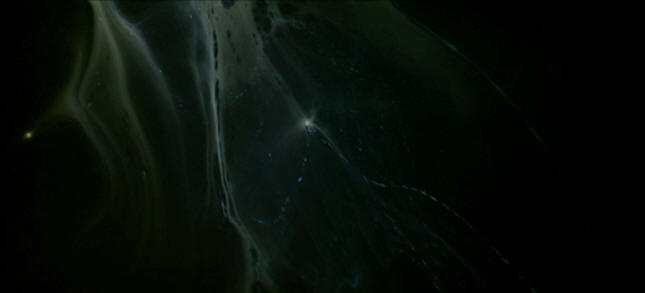
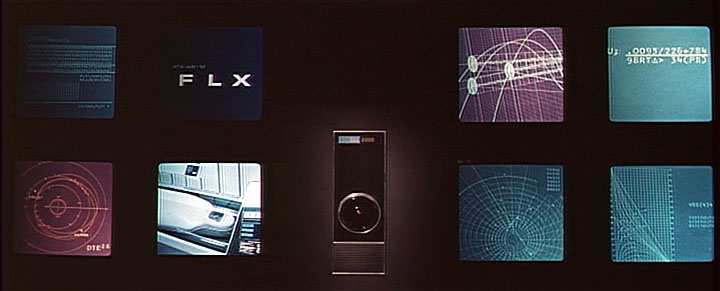
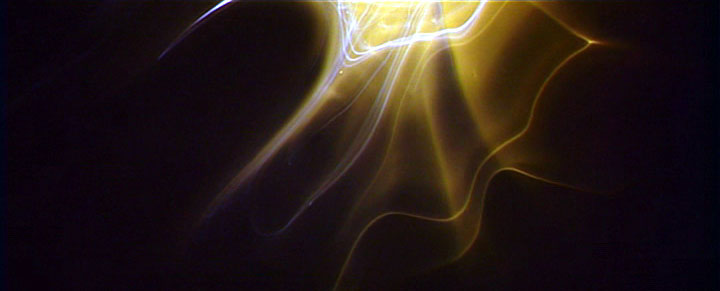
Other clues of a dream sequence are that the first monolith came to the apes when they were asleep and the illogical movements of the floating pen aboard the Pan Am ship suggest that Floyd may have been dreaming about a floating monolith as well.
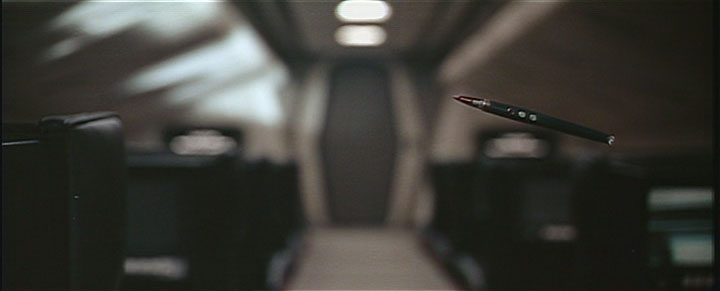
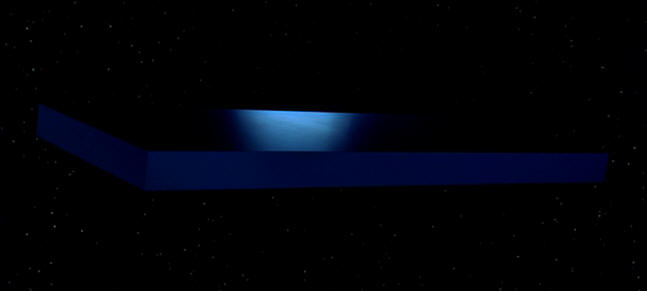
It’s also worth noting that one of the functions of dreams is for the unconscious mind to assimilate information that the waking mind has gathered, but can’t easily process. In a way this sums up the puzzle aspect of the film. The dazzling stargate bombards us with complex, but mostly irrelevant, patterns that distract us from making the simple observation of a vertical to horizontal shift.
After the initial shots of exploding consciousness we are presented with the small yellow and red explosion, which I’ve already interpreted as a heart beat. This shot could also be a representation of HALs red and yellow eye exploding in a way that is dwarfed by Bowman’s intellectual growth.
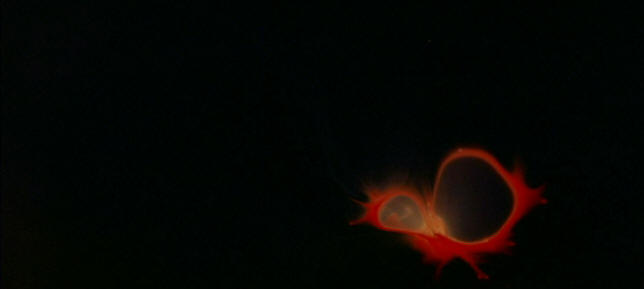
When Bowman arrives in the Renaissance room the display screens in the pod flash the words “non function” indicating that Bowman has arrived in a dimension that can’t be comprehended by formal logic. He has entered the symbolic realm of dream logic.
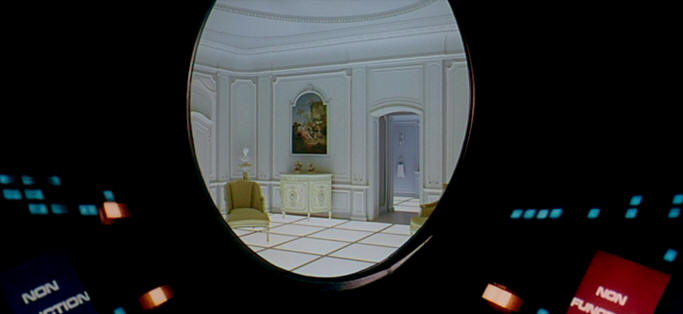
As the scene progresses all traces of technology gradually disappear from Bowman’s existence. The scene starts with wide angle lens shots, similar to HALs vision, but these give way to more standard lens shots indicating that HAL is no longer watching. The pod disappears and is replaced by a dining table. Bowman's space suit and muffled breathing disappear and are replaced by real clothes and real breathing. For this first time in the film we are seeing furniture made from natural materials. In the mirror of the bathroom we can see a real toilet instead of an anti gravity one. The mirror itself is a drastic contrast to the digital television displays featured earlier in the story, in which Poole and Bowman were watching pre-recorded transmissions of themselves.
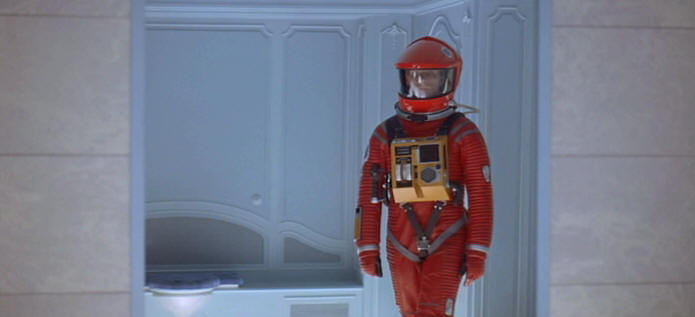
In an aesthetically similar scene Floyd’s voice patterns were read by a computer, but in the bathroom mirror scene Bowman has self-recognition and the echoed voices we hear are indecipherable.
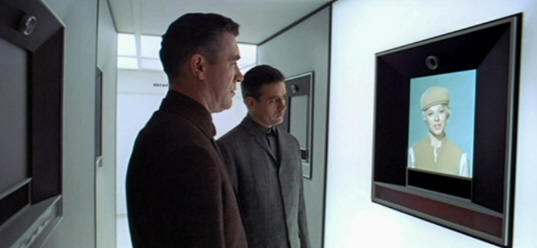
This is also the first scene in the film that a character eats real food instead of processed mush. He also drinks real wine as opposed to synthetic juices. We also have real gravity instead of Torus wheels or grip shoes (notice how Dave treads carefully across the bright tiled floor as if expecting to float upward) and there are candles on the walls instead of electrical lights, though it’s strange that Kubrick chose not to have the candles lit. The candles could also be symbolic of a happy re-birthday celebration for Bowman. He also ages rapidly, which is the opposite of both hyper sleep and the slow-motion pace of life aboard the Discovery.
On the discovery ship astronauts were unable to dream while in hypersleep, but here Bowman can sleep and dream naturally in a real bed. As an additional supporting point, dream logic was also a prominent feature in Kubrick’s last film Eyes Wide Shut.
The strange mixed up logic of the entire ending of 2001 fits perfectly with the idea that Bowman is mentally evolving in his sleep aboard the Discovery, which he has seized back from HAL’s clutches.
The renaissance paintings and ornaments probably carry several meanings such as a recovered appreciation of natural beauty or artistic expression. They may be scenes of courtship, indicating a recovered sense of love or intimate contact with other humans.
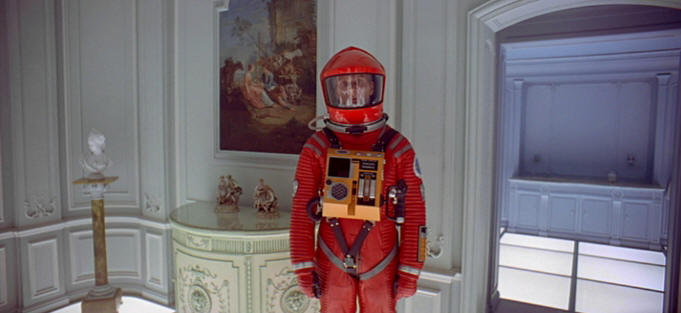
Another possible parallel with Eyes Wide Shut’s symbolism may be that the paintings represent symbolic mirrors or windows – notice that they are etched into alcoves in the walls rather than simply being framed.

Combined with the presence of real gravity, the paintings seem to indicate that Bowman is back on Earth. Notice that as he walks toward us in his robe he is framed by the content of one of these paintings. At this point he also looks quite at home in his surroundings and has distanced himself so far from technology that he can barely remember his former self.
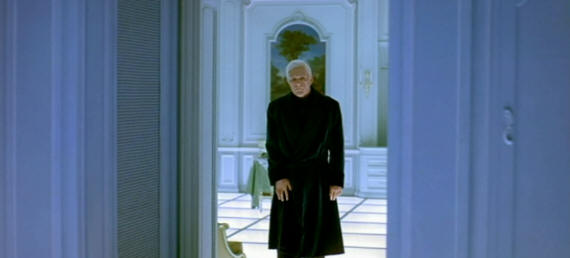
The bathroom is also bathed in the same hue of blue light as the skies in the paintings. Bowman’s former self may also be depicted in the painting behind him. It’s difficult to see closely but a red caped character seems to be hanging from a tree.
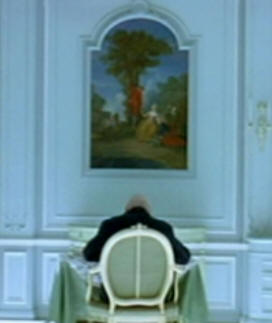
This could symbolize the discarding of the space suit, though I suspect it is part of an overall reference in the paintings to some historical events that are relevant to the story. If anybody out there with a good knowledge of renaissance art can decipher these pictures then I’d much appreciate your comments.
The concept of Bowman’s figure being embedded in the paintings is pronounced in the ornaments that mimick the characters in the paintings and in the statues opposite the bed. The two statues are holding wine glasses above their heads and are standing in alcoves against an Earthy brown background, possibly toasting Bowman’s rebirth. This could also be signifying that bowman’s smashing of a glass is a toast to his recovered natural state of being.
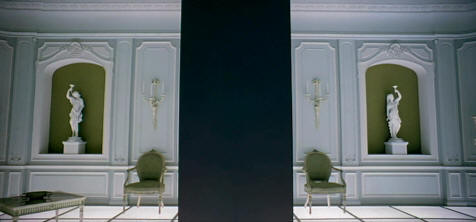
The natural greens and browns of the paintings are also featured in the furniture of the room as if exaggerating the presence of natural materials. Bowman is reborn as an illuminated baby on a brown bed with a green headboard. This is a baby born free of technological constraints. And what did Floyd’s daughter request for her birthday … a bush baby! This so-called “star child” is not born of the heavens. It is born in its natural habitat with the benefits of true enlightenment.
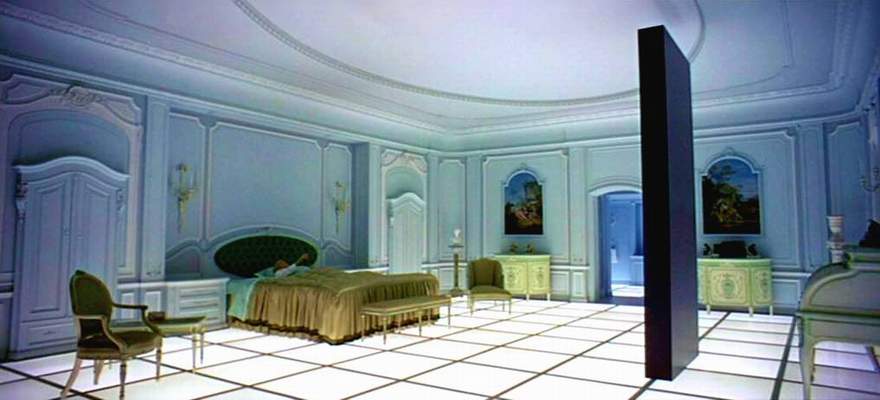
This theme of man escaping technological enslavement and returning to his natural state is the only interpretation I’ve found that satisfactorily explains the assorted details of 2001’s ending. Such anti-technological control themes have become popular in more recent sci-fi classics like Bladerunner and The Matrix. Although The Matrix is a very original take on the idea of technological enslavement, 2001 came a full 30 years earlier and shows us just how far ahead of his time Kubrick was. And even in the age of computer graphics 2001 is visually sublime.
Along similar lines, another interpretation of the Discovery ship is that if viewed at a 90 degree angle it makes a convincing symbol of technology as a ball and chain - forever pulling man down. Remember also that there is no sense of orientation in space.
